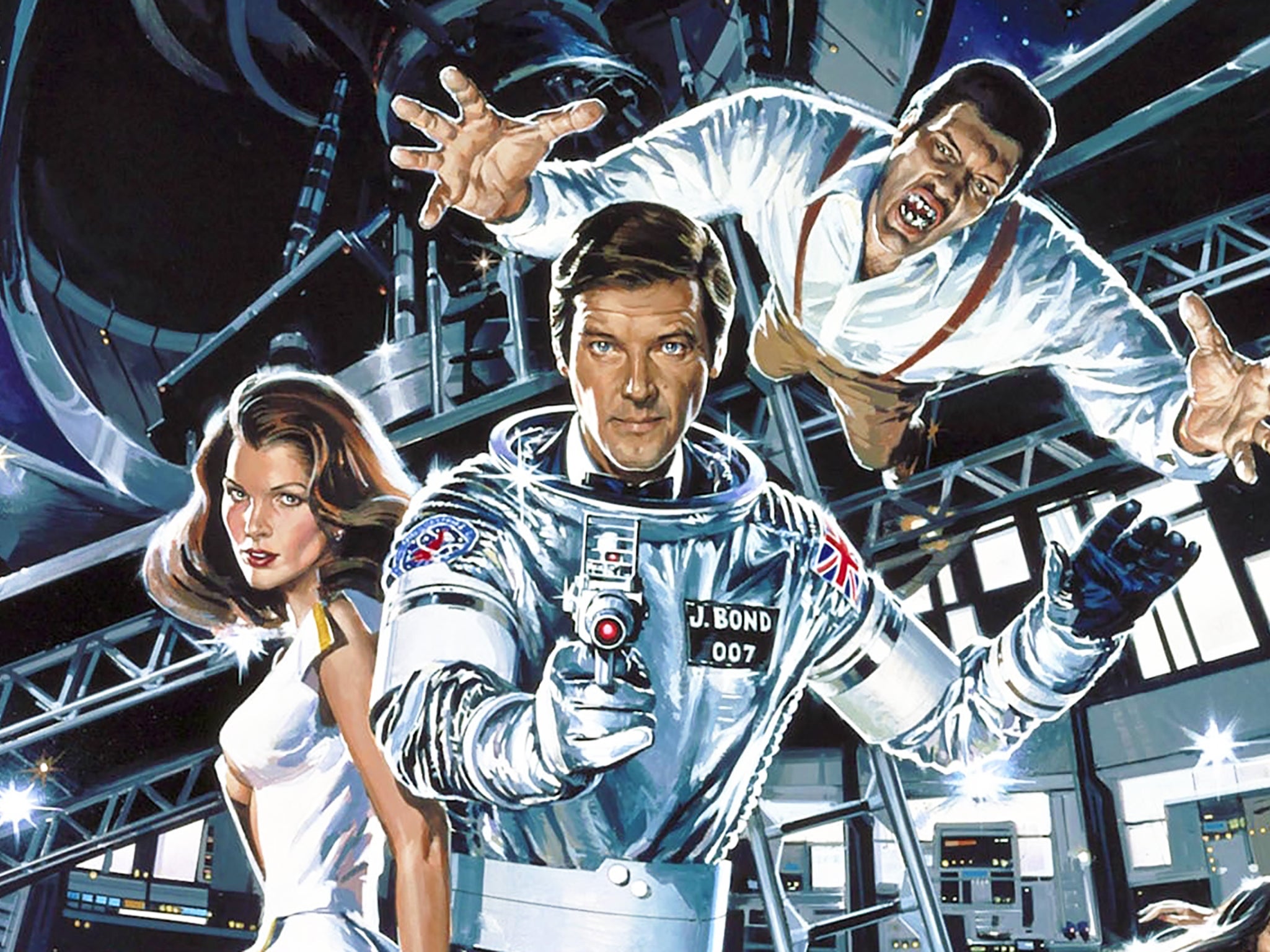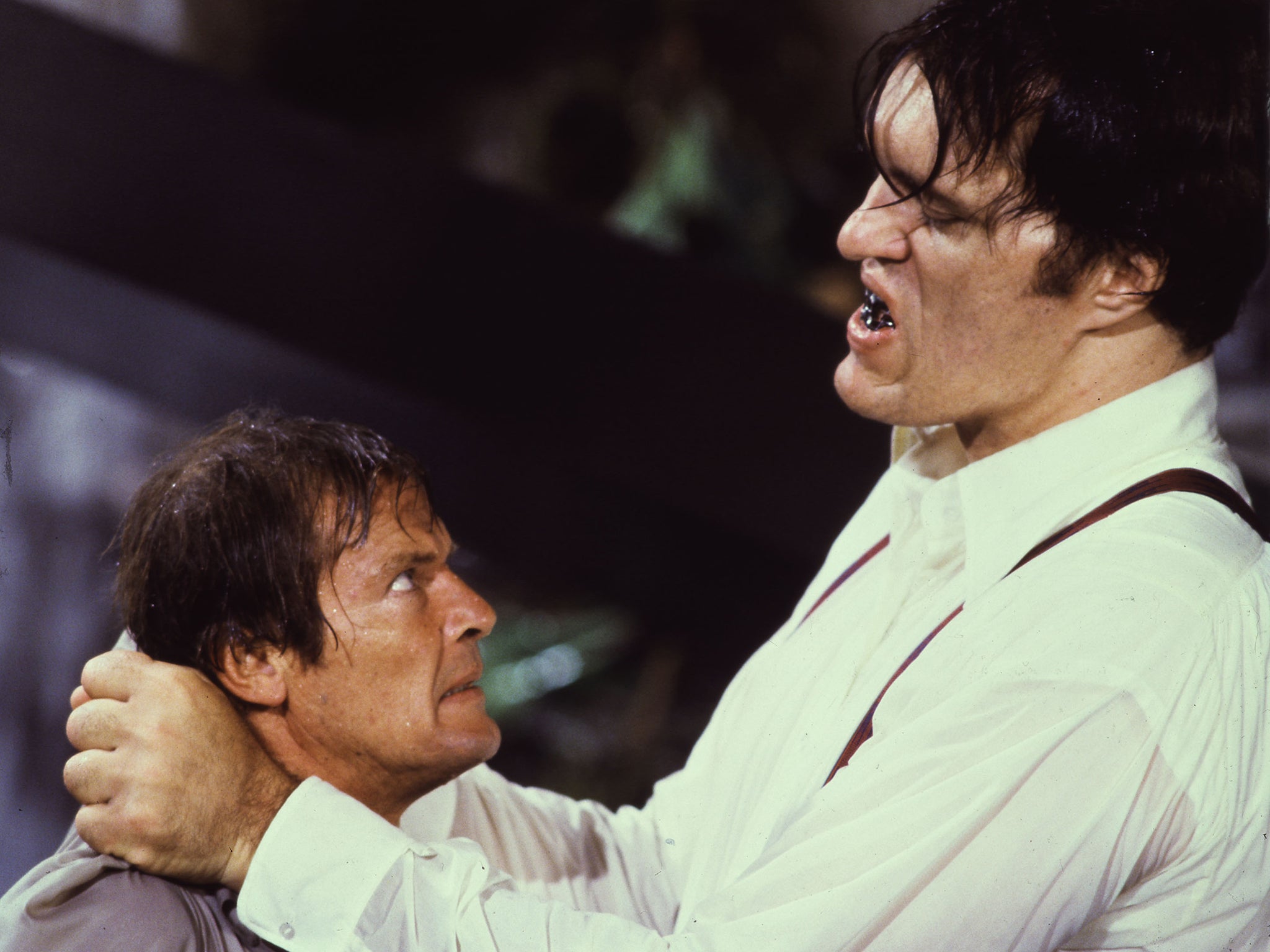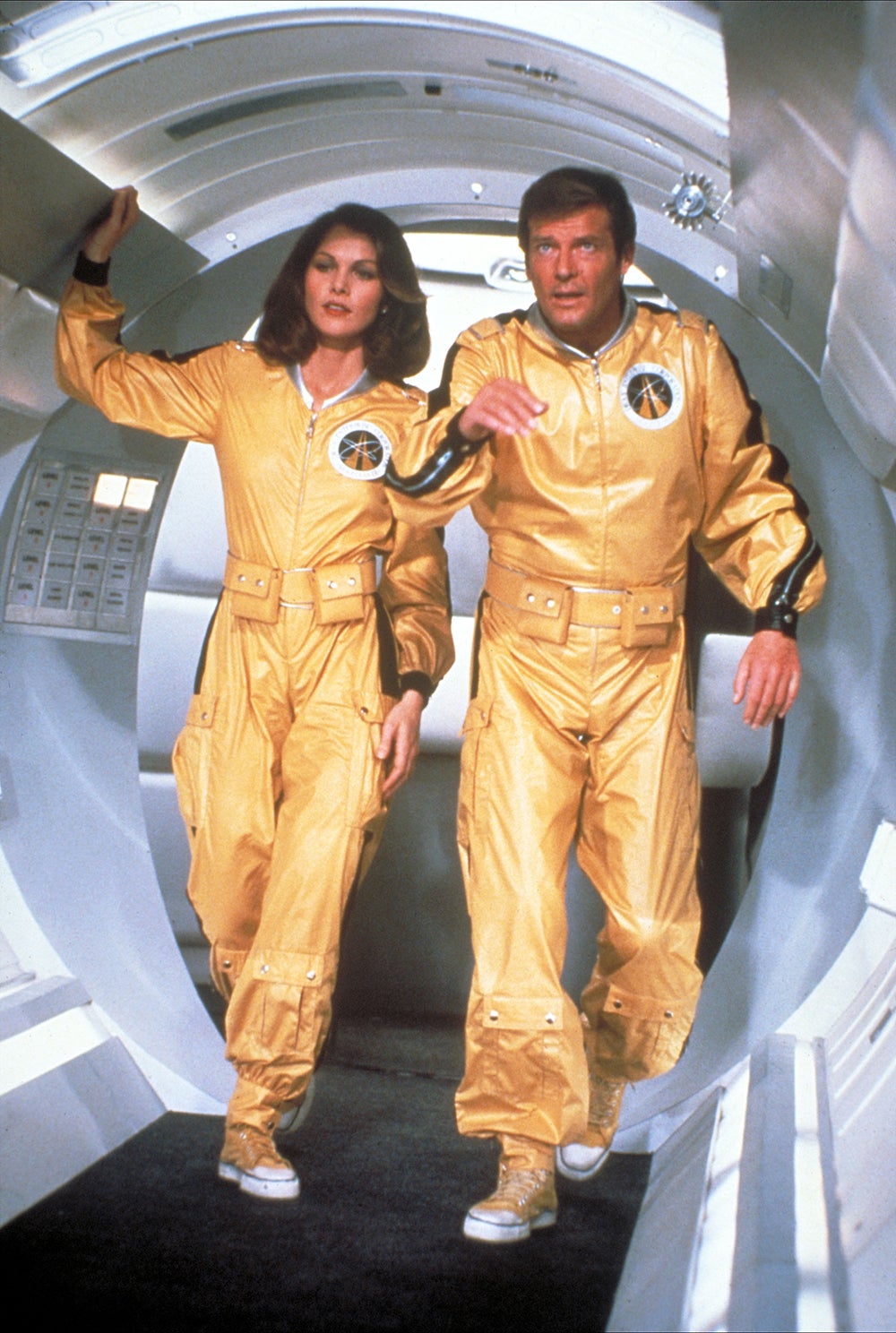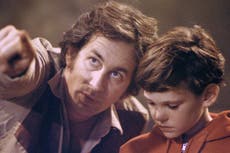Is Moonraker the worst Bond movie ever or an unheralded 007 masterpiece?
Quentin Tarantino and Roger Avary have had heated discussions about the merits of the 1979 film. Is it as transcendentally brilliant as Avary argues or as much of a train wreck as Tarantino suggests? Geoffrey Macnab weighs up the pros and cons

It’s the James Bond movie in which Roger Moore’s 007 has sex in zero gravity, in outer space, while the Queen watches back home via a satellite transmission.
“My God, what is Bond doing?” M splutters.
“I think he is attempting re-entry, sir,” a distracted Q volunteers.
Over the past 43 years, no one has paid too much attention to Moonraker (1979), a “spy-fi” adventure that did excellent box office at the time without making much impact on critics. With its smutty puns and tongue-in-cheek humour, it didn’t look as if it was intended to be taken seriously. The general consensus is that it is better than the final Moore films (Octopussy, A View to a Kill), but no masterpiece.
Now, though, Moonraker is being thoroughly re-examined. It has been the subject of prolonged and very intense debate on The Video Archives, the new podcast launched earlier this summer by filmmaker Quentin Tarantino and his Pulp Fiction co-writer and fellow film nerd, Roger Avary.
“Is Moonraker one of the best Bond films of all times or is it the absolute, bottom-of-the-barrel worst?” the podcast asks.
This doesn’t exactly seem like a burning question for our times but once Tarantino and Avary crank into gear, their discussion is both illuminating and very funny.
Tarantino isn’t a fan. The motormouthed US director may have a reputation for watching almost every film ever made in the days when he worked as a video store clerk, but somehow Moonraker passed him by in 1979. Having finally caught up with it recently, he is underwhelmed. “To me, the whole thing is, not whimsical, it’s cynical. The whole movie... is cynically ripping off Stars Wars in this cash-grab kind of way... to me, it’s base,” Tarantino fulminates.
Initially, Avary hadn’t liked Moonraker either. “For years, it was the worst James Bond movie to me,” he says, remembering his reaction after seeing the film the first time around. Then, though, came the moment of revelation, after he watched it again through his daughter’s online film club. “It was like I had been walking along a desert and I had been starved and then suddenly I had come upon an oasis,” he rhapsodises.
This time, Avary loved the shape-shifting form of Moonraker and the quickfire way it skips between genres. “It’s a spy film, it’s an action movie, it’s a romance, it’s a travelogue, it’s a sci-fi, sure. It is also a horror film... I am talking about the way it switches its tone. It becomes whatever it needs to be in the moment. It’s a comedy. It’s a western, even, at one point.”
At points, as he extols the brilliance of the 11th Bond movie, Avary sounds like an awe-struck art lover who has just tilted his head upward and seen the wonder of Michelangelo’s Sistine Chapel ceiling for the very first time.
So where does Moonraker really stand? Is it as transcendently brilliant as Avary argues or as much of a train wreck as Tarantino suggests?
This is one Bond movie that can’t stay still for more than a few moments. Its dizzying range of locations stretches from Venice (where there’s a ridiculous gondola chase, culminating in Bond driving his boat across St Mark’s Square) to Rio during Carnival; from deep in the Amazon jungle to even deeper in outer space.
Bringing back Richard Kiel as Jaws, the oversized thug with the serrated metal teeth who had first appeared in The Spy Who Loved Me (1977), is surely a terrible tactical mistake, reducing the Bond franchise to the level of big-screen pantomime. Worse, the script turns Jaws into an object of comedy and pathos rather than one of extreme malevolence. He is even provided with a girlfriend in the shape of the pig-tailed, bespectacled, Rapunzel-like Blanche Ravalec.

The film is shamelessly derivative, too. It has its own equivalent of the Death Star space station in Star Wars. Its Asian henchman Chang (Toshirô Suga) seems directly inspired by Burt Kwouk’s Cato Fong in the Pink Panther comedies. Just like Cato (forever ambushing Peter Sellers’ Inspector Clouseau), Chang keeps turning up in unexpected places, ready to pounce on Bond.
Wearing his Moss Bros-like tweed jackets, blazers and suits, Moore, as the spy hero, is already looking distinctly middle-aged. He behaves very gingerly in the action sequences, never allowing himself to work up a sweat – whether wrestling with a python or dangling from a cable car. The director, Lewis Gilbert, meanwhile, seems far more interested in the gadgets than in the characterisation.
You can, then, understand the critical indifference with which the film has been treated.
Then there is Hugo Drax, the urbane villain played by Michael Lonsdale who can’t help but seem to modern audiences like the Bond universe’s prophetic early version of Elon Musk. He too is one of the world’s richest men, a billionaire industrialist desperate to travel into outer space. Drax even sounds like Musk, making wittily ironic remarks that echo the barbed tweets fired out by the Tesla boss today.
There is one aspect of the film about which everybody can agree – the excellence of Ken Adam’s production design. Moonraker is full of elaborate sets devised by the Berlin-born, Bauhaus-influenced, former wartime RAF pilot who has long been acknowledged as one of the visionary figures in UK cinema. Adam worked on Stanley Kubrick films (Dr Strangelove and Barry Lyndon) as well as Chitty Chitty Bang Bang and many of the Bonds. Moonraker had a huge budget for its time and Adam was able to give full vent to his imagination, taking inspiration for his designs from Dutch abstract modernist, Piet Mondrian – one reason why the film wouldn’t look out of place in Tate Modern.
Adam’s pièce de résistance is the rotating centrifuge that he created for an early action set piece. Bond is strapped in and the machine whizzes around at such reckless speed that it looks as if his eyes are going to come out of his head and his guts explode from his chest.
The stunt work is top-notch, too. In the astonishing opening sequence, Bond is pushed out of a plane without a parachute. He tussles with an antagonist in mid-air, steals the other man’s harness, and then outmanoeuvres Jaws, who is trying to bite him in half. True, the stunt performers don’t look very much like the actors they are portraying but the sequence is so realistic (made without CGI) and has such giddy intensity that few viewers spot the joints. Even Tarantino likes it. “It blew me away,” the Reservoir Dogs director admits.
The plotting is on the haphazard side. A US Moonraker shuttle on loan to the UK is snatched in mid-air. Bond is sent to investigate the heist and soon discovers that Drax is behind it. The billionaire industrialist wants to create a new master race in space, kill everybody on Earth and start civilisation all over again. Bond has to go around the world, and eventually into orbit, to bring him to justice.
This is one Bond movie with a strong Gallic flavour. Much of it was shot in France, but not for legitimate story reasons. Adam claimed to his biographer Christopher Frayling that director Gilbert, producer Albert R Broccoli and star Moore all had tax problems in the UK and therefore didn’t want to make the film in England.

One of the camera operators was Jacques Renoir, great-nephew of the legendary French director Jean Renoir. The film’s most eccentric sequences bear a passing resemblance to Jean Renoir’s masterpiece, the country house drama The Rules of the Game (1939). Drax has reconstructed his own version of a French chateau deep in the heart of California. He holds a pheasant shoot in the strangely lush and verdant woods surrounding the chateau. Bond hits a gamekeeper/assassin who’s hiding up a tree, trying to kill him.
It is patently obvious that we are in Europe, not on the west coast of America, but the creative use of geography is one of Moonraker’s most disorienting and distinctive features. Every time there is an edit, Bond turns up on a new continent.
The Tarantino podcast struggles to make much sense of the sexual politics. Tarantino is thoroughly unconvinced by Lois Chiles’ Dr Holly Goodhead. He later worked with Chiles himself and rates her highly but suggests her character here is a complete nonentity with a terrible fratboy-style name that wouldn’t pass muster in a “Porky’s rip-off”.
Avary counters that Holly is one of the first heroines who is an equal to Bond himself. She is a CIA spy, a scientist and an astronaut. She is good with her fists, too.
“After a string of, in my opinion, a little bit boring Bond girls, we got a smart, intelligent brunette,” Gala Avary, Roger Avary’s producer daughter, joins in the discussion, making the case for Holly as one of the best “Bond girls” in the entire franchise.
So what is the final verdict on Moonraker?
Inevitably, Tarantino and Avary argue themselves to a standstill. One highlights the film’s many flaws. The other extols its virtues. They can’t get through each other’s armour. Both continually experience the same sinking sensation as Bond when he kicks Jaws in the nether regions, hears a metallic ring and realises he has hurt his foot.
Neither definitively prove their case. What their podcast does prove, though, is that when you feel this passionately, it can be just as much fun to talk about a movie as to watch it.
‘Moonraker’ is available to rent and buy on Prime Video. The Tarantino podcast is found here
Join our commenting forum
Join thought-provoking conversations, follow other Independent readers and see their replies
Comments


Bookmark popover
Removed from bookmarks